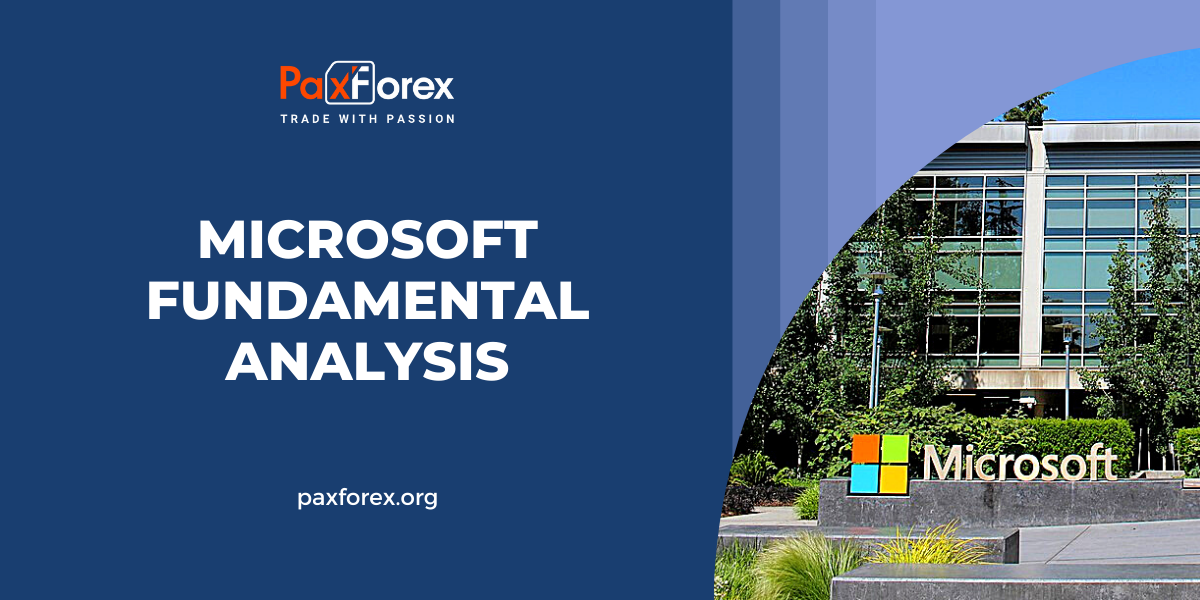
Source: PaxForex Premium Analytics Portal, Fundamental Insight
Microsoft's stock has exhibited impressive performance throughout the year, achieving a remarkable 34.55% rise, surpassing the S&P 500's 9.2% increase. Nevertheless, some skeptics argue that the stock may be overvalued and lack substantial room for future expansion. These critics highlight the consensus analyst price target of $323.28, which implies a limited potential for upward movement in the coming year.
However, it is crucial to consider alternative perspectives and direct attention toward two significant factors that drive long-term growth. By disregarding analysts' price targets, you can gain a more comprehensive understanding of Microsoft's potential for sustained development.
An analyst consensus price target represents the average prediction of all analysts covering a specific stock. Typically, it serves as a 12-month forecast that encourages short-term investing. However, there are multiple reasons why engaging in short-term investing can be detrimental to many investors, primarily due to its higher level of risk compared to long-term investing.
Short-term investors face the potential for significant fluctuations in stock prices within a short span of time, increasing the likelihood of losses. Moreover, short-term investors are more prone to making emotional decisions and being influenced by market volatility. Consequently, they may sell their investments when prices decline, even if they recognize the stock's positive long-term prospects.
Therefore, it is often advisable to shift focus toward a company's long-term considerations. For Microsoft, two crucial drivers of long-term growth are digital transformation and artificial intelligence (AI). By prioritizing these factors, investors can better assess the company's potential for sustained expansion.
Digital transformation encompasses the use of electronic systems, devices, and cloud computing to revolutionize business operations and enhance customer experiences. It entails adopting new technologies, reengineering business processes, and creating innovative products and services.
By offering numerous tools, Microsoft empowers organizations to embark on their digital transformation journeys, enabling them to leverage cutting-edge technologies and enhance their competitiveness in the digital era.
Microsoft holds a significant competitive edge over its rivals, thanks to its longstanding customer relationships established through its Windows Server product line and other traditional software offerings such as Office. These strong relationships position Microsoft favorably when its existing clients embark on their digital transformation journeys, as they often choose Microsoft due to their trust in the company's products and services. This trust makes the transition to digital solutions smoother and more seamless. Furthermore, Microsoft has a distinguished track record of innovation, instilling confidence in its customers that they are partnering with a reliable and forward-thinking company.
The digital transformation market is vast and experiencing rapid growth. According to forecasts by Statista, this market is projected to expand at a compound annual growth rate (CAGR) of 16.32%, surging from $2.16 trillion in 2023 to an estimated $3.4 trillion by 2026. Given this remarkable growth trajectory, it is evident that digital transformation will be a significant driver of Microsoft's expansion in the foreseeable future. The company is well-positioned to capitalize on this market opportunity and leverage its strengths to capture a substantial portion of this growth.
During Microsoft's fiscal third-quarter 2023 earnings report, CEO Satya Nadella emphasized the company's aspirations to lead in the field of artificial intelligence (AI). One compelling reason for this focus is the significant role AI plays in driving the growth of cloud computing. Modern AI technologies demand substantial computing resources, which can be efficiently provided on demand through cloud computing. Moreover, AI relies on accessing and analyzing vast amounts of data, a capability facilitated by cloud computing's robust storage capabilities. The cloud also simplifies the sharing of AI models and data, fostering collaboration and enabling innovation.
Nadella alluded to the potential of AI in fueling cloud growth with the following statement during the company's recent earnings call.
Nadella's remarks underscore Microsoft's commitment to leveraging AI as a driving force behind the expansion of its cloud services, showcasing their powerful AI infrastructure and the collaborations they have established with key industry players.
Numerous technology experts anticipate rapid growth in the AI market over the next decade. For instance, according to Next Move Strategy Consulting, the AI market was valued at $142.32 billion in 2022, and it is projected to reach approximately $1.8 trillion by 2030, reflecting a compound annual growth rate (CAGR) of 37.8% over eight years. As AI technology proliferates, it is expected to serve as a significant driver of growth for Microsoft.
Although IDC predicts a slight slowdown in cloud software revenue growth, estimating a 19% increase in 2023 compared to 25% in 2022, this deceleration can be attributed to global economic uncertainties, which have made businesses more cautious about investing in new technologies. During the third-quarter 2023 earnings call, CFO Amy Hood acknowledged that Azure customers exhibited some caution in their spending.
However, industry experts remain optimistic about the cloud software market's substantial growth in the upcoming years, driven by the sustained demand for cloud-based solutions across businesses of all sizes.
Microsoft finds itself at the forefront of two major early-stage business trends. As an investor seeking a reliable company with the potential for significant long-term gains, Microsoft stands out as one of the top choices. With its strong position in AI and its expertise in cloud computing, Microsoft is well-positioned to capitalize on these transformative trends and drive substantial growth in the future.
As long as the price is above 312.00, follow the recommendations below:
- Time frame: D1
- Recommendation: long position
- Entry point: 332.67
- Take Profit 1: 340.00
- Take Profit 2: 350.00
Alternative scenario:
If the level of 312.00 is broken-down, follow the recommendations below:
- Time frame: D1
- Recommendation: short position
- Entry point: 312.00
- Take Profit 1: 303.00
- Take Profit 2: 295.00













